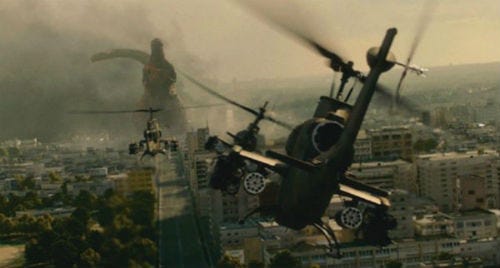Godzilla: Resurgence
“Godzilla: Resurgence” is only playing in Indianapolis sporadically for the next few weeks. The first showing is Tuesday, October 11 at the Landmark Keystone cinema at 7 p.m.
I wanted to make it as clear as possible. Go see it.

There are generally two types of Godzilla stories. The allegorical story features Godzilla as a monstrous representation of man's sins turned back on them. This can be told using only Godzilla or with other monsters for him to fight. "Gojira" (1954), "Godzilla" (1984) and "GMK" (2003) are examples of this type of story.
There are also the 'Godzilla as super-monster" stories like "Invasion of the Astro-Monster" (1965), "Destroy All Monsters" (1968) or "Final Wars" (2004). The latter is the Godzilla most kids know and love. The former is what makes him such an enduring and influential idea.
Aside from the American-made Godzilla movies from 1998 and 2014, the other 28 movies all acknowledge the original film in some form or another within their own narratives. “Resurgence” doesn't do this; It fully reboots the story for a new generation. Its lack of narrative self-awareness means that Godzilla now serves as an allegory not for war or weapons, but for the Fukushima Daijchi nuclear disaster, the Tohoku tsunami and, ultimately, how civilian peacetime governments react to disaster. It's a different take.
Like most of the solo-Godzilla movies, the G-Man is only on screen for about 30% of the running time and mostly serves to forward the human drama. The people in question are Japanese government representatives, and the drama comes from watching them work off of intelligence reports and social media to determine the nature of the disaster occurring and precisely how to handle it.
Directors Hieaki Anno and Shinji Hiuchi change Godzilla's character to create a new kind of rolling tension: he starts as a larval creature with minimum capacity for damage, but slowly grows into the largest version of the character ever seen on film. We learn about him as they learn about him. The tension feels real, and the human cost is never understated.
Human cost is something that the Godzilla films have tried to depict for years, but they usually fall short. I think "Godzilla" (2014) did a good job visually but ultimately depicted a very human-focused monster whose heroism undercut the horror of his presence. “Godzilla: Resurgence” refuses to make “Godzilla” anything but the ultimate result of human folly. He demands repentance for our sins, and it is only through reflection and contrition that we find a solution.
You might think this is a boring movie. I didn't think so, but if you walk in expecting "Pacific Rim," "Godzilla" (2014) or any of the monster fight movies you might feel a little sleepy halfway through. Sorry. This is a dark, pessimistic political thriller with Godzilla as catalyst. It doesn't pull punches and doesn't feel terribly hopeful. It's the closest we've ever had to the original "Gojira."
“Resurgence” isn't for everyone. If you have an aversion to giant monster movies, don't think I'm telling you to show up on Tuesday. But if you're open to a movie about members of the Japanese bureaucracy trying to figure out where they went wrong culturally — in a manner that deserved such holy reckoning in the form of a giant green lizard with fire breath and a nasty disposition — see this movie.


